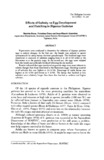Effects of salinity on egg development and hatching of Siganus guttatus
- Global styles
- MLA
- Vancouver
- Elsevier - Harvard
- APA
- Help
Share
抄録
Experiments were conducted to determine the tolerance of Siganus guttatus eggs to salinity changes. In the first run, the female was induced to spawn spontaneously by using human chorionic gonadotropin. The fertilized eggs were transferred to seawater of salinities ranging from 8 to 40‰ either at the blastomere or at the gastrula stage. In the second run, the eggs were stripped from the female and artificially fertilized following the dry method.
Results indicated that eggs transferred at gastrula stage were more tolerant to salinity changes than those transferred at the blastomere stage. Hatching occurred at all salinities but was highest at 24‰. Percentage of viable larvae was highest at 24‰ and lowest at 8‰. The larvae that hatched at low salinities were relatively longer than those that hatched at ambient and higher salinities.
記述
Contribution No. 195 of the Aquaculture Department, SEAFDEC.
Suggested Citation
Duray, M. N., Duray, V. M., & Almendras, J. M. (1986). Effects of salinity on egg development and hatching of Siganus guttatus. The Philippine Scientist , 23, 31-40. http://hdl.handle.net/10862/1181
Type
ArticleISSN
0079-1466Collections
- Journal Articles [1249]


